Related Research Articles
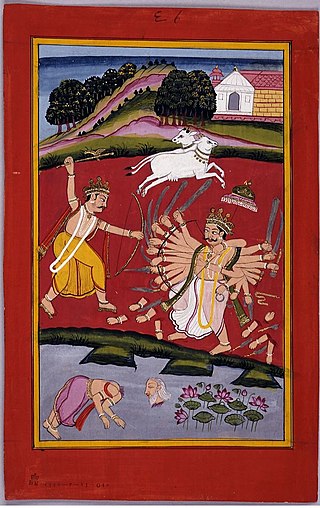
Jamadagni is a sage in Hindu literature. He is regarded in Hindu tradition to be one of the Saptarishi in the 7th, and the current age of Manvantara.
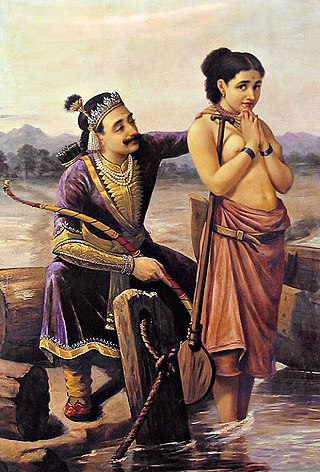
Satyavati was the queen of the Kuru Kingdom. Satyavati is married to king Shantanu of Hastinapura, and is the great-grandmother of the Pandava and Kaurava princes. She is also the mother of the seer Vyasa, author of the epic. Her story appears in the Mahabharata, the Harivamsa, and the Devi Bhagavata Purana.

Kamadhenu, also known as Surabhi, is a divine bovine-goddess described in Hinduism as the mother of all cows. She is a miraculous cow of plenty who provides her owner whatever they desire and is often portrayed as the mother of other cattle. In iconography, she is generally depicted as a white cow with a female head and breasts, the wings of a bird, and the tail of a peafowl or as a white cow containing various deities within her body. Kamadhenu is not worshipped independently as a goddess. Rather, she is honored by the Hindu veneration of cows, who are regarded as her earthly embodiments.
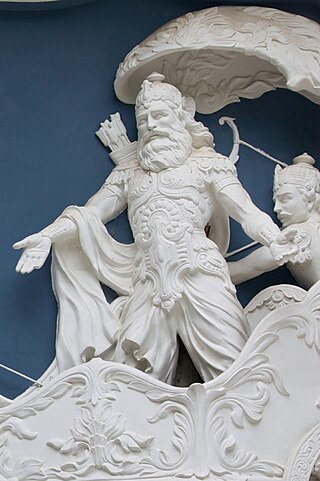
Bhishma, also known as Pitamaha, Gangaputra, and Devavrata, was a prince, statesman and commander of ancient Indian Kuru kingdom and is a major character of the epic Mahabharata and the protagonist of the Bhishma Parva episode. He was the supreme commander of the Kaurava forces during the Kurukshetra War. He was the only character who witnessed the entirety of the events of the Mahabharata, beginning from the reign of his father, King Shantanu of the Kuru kingdom. Bhishma was the stepbrother of Vyasa, the grandfather of both the Pandavas and the Kauravas. He was a prominent statesman of the Kuru Kingdom. He was born as the youngest son of the King Shantanu and goddess Ganga.

Pandu was the king of Kuru kingdom, with capital at Hastinapur in the epic Mahabharata. He was the foster-father of the five Pandavas, who are the central characters of the epic.

Droṇa, also referred to as Dronacharya, is a major character of the Hindu epic Mahabharata.

Dhritarashtra was a Kuru king, and the father of the Kauravas in the Hindu epic Mahabharata. He was the King of the Kuru Kingdom, with its capital at Hastinapura. He was born to Vichitravirya's first wife, Ambika.
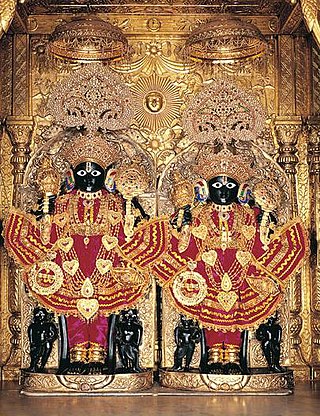
Naranarayana, also rendered Nara-Narayana, is a Hindu duo of sage-brothers. Generally regarded to be the partial-incarnation (aṃśa-avatara) of the preserver deity, Vishnu, on earth, Nara-Narayana are described to be the sons of Dharma and Ahimsa.
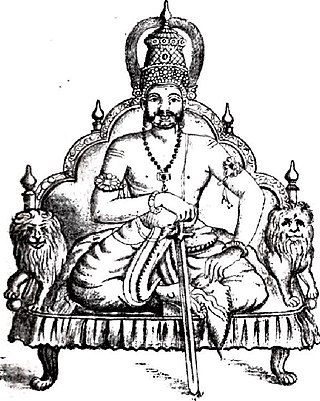
Yayati is an Abhira king in Hindu tradition. He is described to be a Chandravamsha king. He is regarded to be the progenitor of the races of the Yadavas and the Pandavas.

Parīkṣit was a Kuru king who reigned during the Middle Vedic period. Along with his son and successor, Janamejaya, he played a decisive role in the consolidation of the Kuru state, the arrangement of Vedic hymns into collections, and the development of the orthodox srauta ritual, transforming the Kuru realm into the dominant political and cultural center of northern Iron Age India. He also appears as a figure in later legends and traditions. According to the legendary accounts in Mahabharata and the Puranas, he succeeded his grand uncle Yudhishthira to the throne of Hastinapur.

Bharata is a legendary emperor featured in Hindu literature. He is a member of the Chandravamsha dynasty, and becomes the Chakravarti. He is regarded to be the ancestor of the Pandavas, the Kauravas, Brihadhrata, and Jarasandha.

Kosala is the kingdom of Rama mentioned in the Ramayana. Ayodhya was its capital, now located in Ayodhya, Uttar Pradesh. Rama's sons Lava and Kusha inherited parts of this kingdom. Lava ruled from the city called Shravasti and Kusa from the city called Kushavati. A colony of Kosala kings existed in Madhya Pradesh. It was called Dakshina Kosala. Rama's mother Kausalya was from this kingdom. Rama extended his influence up to the island-kingdom of Lanka situated in the Indian Ocean. He had friendly relations with the southern kingdom of Kishkindha.
Sauvīra was an ancient kingdom of the lower Indus Valley mentioned in the Late Vedic and early Buddhist literature and the Hindu epic Mahabharata. It is often mentioned alongside the Sindhu kingdom. Its capital city was Roruka, identified with present-day Aror/Rohri in Sindh, mentioned in the Buddhist literature as a major trading center. According to the Mahabharata, Jayadratha was the king of the Sindhus, Sauviras and Sivis, having conquered Sauvira and Sivi, two kingdoms close to the Sindhu kingdom. Jayadratha was an ally of Duryodhana and the husband of Duryodhana's sister Dussala. The kingdom of Sauvira is also stated to be close to the Dwaraka and Anarta kingdoms. According to Bhagwat Puran Sauviras were once connected with Abhira.
Kalinga is a kingdom described in the legendary Indian text Mahabharata. They were a warrior clan who settled in and around the historical Kalinga region, present-day Odisha and northern parts of Andhra Pradesh. According to political scientist Sudama Misra, the Kalinga janapada originally comprised the area covered by the Puri and Ganjam districts.reference-Sudama Misra (1973). Janapada state in ancient India. Bhāratīya Vidyā Prakāśana. p. 78.
The Keralas or Udra Keralas were a royal dynasty mentioned in Sanskrit epics of ancient India. In the Mahabharata, the Keralian empire took part in the Kurukshetra War by feeding both armies. According to the Puranas, the navigators and survivors of the Yadavas of Dwaraka also settled in Kerala later. Some remnants of the Naga culture are also found here.
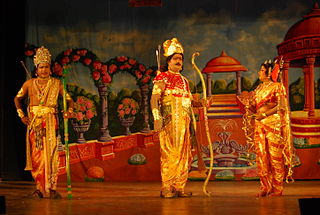
Chitrāngadā, is a warrior princess of Manipura in the Hindu epic Mahabharata. She is the only heir of King Chitravahana and was the third wife of Arjuna. She had a son named Babhruvahana with him. The story of Chitrāngadā was adapted by Indian writer, Rabindranath Tagore in his play, Chitra.
Nahusha is a king of the Chandravamsha in Hindu mythology. He is described to be the son of Āyus, the eldest son of Pururavas, and Prabha, the daughter of Svarbhānu.
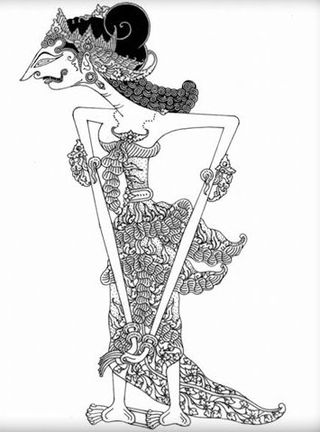
Amba is a character in the Hindu epic Mahabharata. She is the eldest and most beautiful daughter of Kashya, the King of Kashi, and the sister of Ambika and Ambalika.

According to legend, Sarpa Satra or Snake sacrifice was a yagna performed by King Janamejaya of the Kuru Kingdom who had ascended to the throne of Hastinapura upon the death of his father Parikshit. The legend states that Parikshit, the lone descendant of the House of Pandu, son of Abhimanyu and grand son of Arjuna of the Mahabharata fame, had died of snakebite. He had been cursed by a sage to die so, the curse having been consummated by the serpent-chieftain Takshaka. Janamejaya bore a deep grudge against the serpents for this act, and thus decided to wipe them out altogether. He attempted this by performing a great Sarpa Satra – a sacrifice that would destroy all living serpents. At that time, a learned sage named Astika, a boy in age, came and intervened to stop the yagna; Astika's mother manasa was a Naga and father was Jaratkaru a saintly Brahmin. Janamejaya had to listen to the words of the learned Astika and set Takshaka free. He also stopped the massacre of the snakes (Nagas) and ended all the enmity with them. From then onward the snakes (Nagas) and Kurus lived in peace.
References
- Kisari Mohan Ganguli, The Mahabharata of Krishna-Dwaipayana Vyasa Translated into English Prose, 1883–1896.
